Jessica Knauss's Blog, page 38
March 13, 2013
The Hope Factory by Lavanya Sankaran with Giveaway
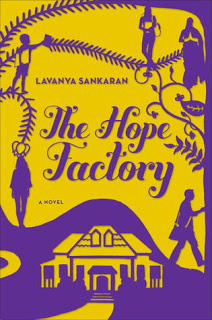 What a good boy, the old lady would say. The answer to a mother's prayers.
What a good boy, the old lady would say. The answer to a mother's prayers."Yes," Kamala would say, and through her mind would fly this thought: Yes, an answer to my prayers, but did the gods have to let it take this form?
Because of certain life events I've never divulged on this blog, I fancy I know just a tad more about India than the average Anglo-American. I haven't been there, but The Hope Factory gives such a compelling picture of Bangalore it's almost as if I not only traveled there but also got to know two families intimately.
The novel tells two parallel stories that only coincide because Kamala is a maid in Anand's house. While it might appear that Kamala struggles to survive and Anand has only a business man's problems, the socio-political climate they're living in treats them both as expendable, and before the book is over, Anand faces some serious threats that might undo everything he has ever worked for.
I sympathize more with Kamala because she faces such serious threats to her survival on a daily basis. The slightest mood swing of her employer and she'll be back on the street with no hope for ever making her son's life better. She shows incredible courage, hard work and sacrifice and it's painful to see that her victories are so small. And this fictional story is probably a lot more true than anyone would like. But Kamala has hope, and that's what makes the book so hard to put down.
Faced with threats, Anand also has an opportunity to show he can make the corrupt system work, by hook or by crook, without compromising his amazingly uncorrupted values. The most exciting parts of the book are the few times when Anand and Kamala come together. It's like the collision of two different worlds. It's wonderful to see that someone who can help Kamala has enough consciousness of her situation to actually help her. But because of her pride no one will ever really know just how much Kamala deserves the help.
The book is beautifully written, with an excellent ear for the distinct language registers. The story builds slowly at first, but by the middle, it has a momentum that would catapult the most cynical through to the last page. This book is for anyone who ever hoped, lost, or sacrificed.
WIN A COPY
This book has not yet been released to the general public. Get the jump on everyone else by winning an advanced reader's copy! Because it's an advanced reader's copy direct from the publisher, it does have a few typo-type errors, but they never impede the enjoyment of the story. It's a paperback when everyone else will be carrying around a heavy hardback!
To enter, follow this blog and leave a comment below. For extra points, tell everyone you know about the giveaway on Twitter and Facebook. While you're there, like my author page. One winner will be randomly chosen at 6 pm CST on March 17 and contacted via email for his/her postal address by March 25.
Good luck!
Published on March 13, 2013 00:30
March 11, 2013
Interview at Korner Kaff
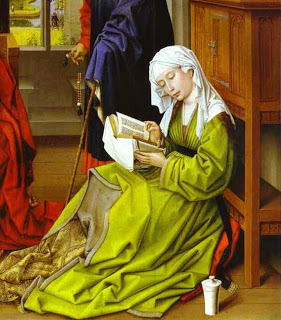
My little, lively, readable, life story as a writer is up at Peter Watson Jenkins's Korner Kaff. It was a really fun interview and it reveals my new Seven Noble Knights of Lara website.
It's the last interview of this type he's doing. Check it out before he takes it down!
Published on March 11, 2013 00:06
March 6, 2013
New Author Sarah Kennedy on Love for Tudor England
Today I'm pleased to present a guest post from Sarah Kennedy, whose novel of Tudor mystery and excitement, The Altarpiece, debuts today.
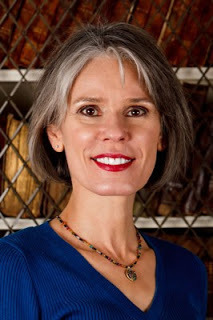 Author Sarah KennedyI’m a native midwesterner, originally from Indianapolis, Indiana, and I’ve always been fascinated by history. After completing a Ph.D. in Renaissance literature, I moved to Virginia. I completed an MFA in writing, and I currently work as a professor of Early British Literature and Creative Writing at Mary Baldwin College.
Author Sarah KennedyI’m a native midwesterner, originally from Indianapolis, Indiana, and I’ve always been fascinated by history. After completing a Ph.D. in Renaissance literature, I moved to Virginia. I completed an MFA in writing, and I currently work as a professor of Early British Literature and Creative Writing at Mary Baldwin College.I’m a poet as well as a novelist, and I’ve published seven books of poems. My writing life was originally fairly separate from my teaching life. My first books were autobiographical and I think some of my colleagues were rather shocked the first time they encountered my poems! Then one summer I was researching old recipe manuscripts at the National Library in Wales, and over the course of those weeks I started thinking about the women who had recorded their hopes and disappointments in those private spaces, and my writing changed. I began writing historical poems, short narratives in the voices of these forgotten women.
Suddenly, my teaching and writing lives merged, and out of that sprang a series of poems about historical figures. I felt that I was filling in the blanks of the literature and literary history I loved. When my sixth book came out, my friend Suzanne Keen at Washington and Lee University said, “Sarah, you should really write a novel.” No way, I thought! I’m a poet!
But the idea must have been brewing in the back of my mind. I read fiction—a lot of it—and one day when my husband and I were in a bookstore (me at the novels, of course) I had an image of a young nun peering through a window as soldiers came up the road toward her. “This day has been coming for years,” I thought—and that’s where the first draft of my novel started.
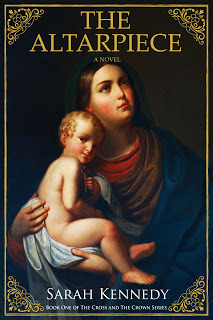 The Altarpiece is the first of a series about Tudor England—one of my favorite historical periods. My main character, Catherine Havens, is a young nun who is being evicted from her convent. She’s devout, but she’s not very orthodox, and the changes in England after Henry VIII’s break from Rome have thrown her into circumstances she never expected. I now get to use Tudor expressions like “how now” and “sirrah” and, my favorite insults, “you villain” “you monkey” without sounding like I’m out of my mind! There are many novels out there about Tudor women, and I wanted to do something different. Rather than use a historical figure as my main character, I created one out of one of those blanks. There are very few records of what happened to nuns after the convents were closed, and I wanted to “make history” with my novel instead of retelling the history we already have.
The Altarpiece is the first of a series about Tudor England—one of my favorite historical periods. My main character, Catherine Havens, is a young nun who is being evicted from her convent. She’s devout, but she’s not very orthodox, and the changes in England after Henry VIII’s break from Rome have thrown her into circumstances she never expected. I now get to use Tudor expressions like “how now” and “sirrah” and, my favorite insults, “you villain” “you monkey” without sounding like I’m out of my mind! There are many novels out there about Tudor women, and I wanted to do something different. Rather than use a historical figure as my main character, I created one out of one of those blanks. There are very few records of what happened to nuns after the convents were closed, and I wanted to “make history” with my novel instead of retelling the history we already have.My writing schedule changed completely. Where once I worked fitfully, between classes and in small allotments here and there, I now sat down every evening after dinner and disappeared into Tudor England. I usually work for several hours in the evening in my favorite chair in the living room, with my husband reading or working right next to me. He’s very understanding when he asks me a question and I don’t hear him! My husband is also my first and best reader, always, and he will tell me when something doesn’t work or when something isn’t plausible. It took me a long time to break the poet-habit of lingering on a scene much too long, and though I won’t ever give up metaphor, I’ve learned to move things along.
Why Tudor England? I’ve been in love with the Tudors since I read Sir Thomas Wyatt’s “Whoso List to Hunt” as an undergraduate, and my feelings are clearly shared by others. The Tudor period is so resonant because it’s a time when political power and religious devotion were tangled—publically tangled—with love and lust. It’s also the period when two women—Mary Tudor and Elizabeth Tudor—were the monarchs in a very patriarchal country. Everything was being called into question—in much the same way that we now question authority and tradition. Can you imagine being a sixteenth-century person and hearing that the earth wasn’t really the center of creation? As power centers shift and the world becomes more and more “virtual,” the Tudors have become one way that we can make sense of our changing world.
When I’m not immersed in the sixteenth century, I love to garden and cook. I teach a lot online, and one of my favorite pastimes is to work with my students, my desk pushed up to the window where I can watch my birds while I write. Sometimes when they’re squabbling and scrabbling for bits, they remind me of my imaginary Tudor world.
Thanks so much to Sarah for sharing such interesting work with us!
Visit Sarah's blog and find The Altarpiece here. Check out a reading from the book here.
Published on March 06, 2013 00:35
March 4, 2013
Winner of Shadow on the Crown
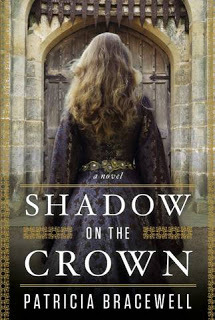 Thanks so much to everyone who entered the Shadow on the Crown giveaway! The lucky winner is bookwormsfancy (Erin), who has a great bookish blog herself. Congrats, Erin! Your book is winging its way to you now direct from Viking.
Thanks so much to everyone who entered the Shadow on the Crown giveaway! The lucky winner is bookwormsfancy (Erin), who has a great bookish blog herself. Congrats, Erin! Your book is winging its way to you now direct from Viking.Coming Wednesday: we move some five hundred years into the future with debut author Sarah Kennedy and her Tudor thriller, The Alterpiece.
Published on March 04, 2013 07:12
February 27, 2013
Author Patricia Bracewell on Old English and Misleading Castles Plus, Win a Copy of Her Great Novel
Hwaet! (That's Old English for "Listen up! I'm going to tell you something you want to hear!") See the end of this post for giveaway instructions.
I was reading The Year 1000 to see if it could tell me something I didn't know about the turn of the eleventh century, in order to use it for The Seven Noble Knights of Lara. (Lots of the atmosphere, none of the history can transfer.) A passing mention of the mysterious, fascinating Queen Emma made me think, "Someone should write a novel about her!" The following week, Shadow on the Crown by Patricia Bracewell came out. It is that novel.

JK: The Year 1000 is a useful book for beginning historical research into the period. Did you encounter any other books that would be accessible to unspecialized readers?
Patricia Bracewell: There are indeed some helpful books out there, some of which you may already have read. The Last Apocalypse by James Reston, Jr. provides a broad look at what was happening in Europe at the end of the first millennium. It’s filled with fascinating gossip about the rulers of the period, although I suspect he plays a little bit fast and loose with facts sometimes! Michael Wood looks at Pre-Conquest England in his book In Search of the Dark Ages . In Bloodfeud: Murder and Revenge in Anglo-Saxon England , Richard Fletcher takes a good look at the politics (and animosities) of the years between 1000 and 1066. For anyone with a specific interest in Emma of Normandy there are two excellent resources: Queen Emma and the Vikings by Harriet O’Brien and Emma: The Twice-Crowned Queen by Isabella Strachan.
JK: Did you read the Anglo-Saxon Chronicle in the original Old English? If so, did it help you set the tone and language for your book?
PB: I have to confess that my knowledge of Old English is limited to a handful of words. I’ve not even seen a copy of the Chronicles in manuscript form - yet. There are versions held at Corpus Christi College, Cambridge, at the British Library in London and at the Bodleian in Oxford, but none easily accessible. I have, though, a wonderful translation by Anne Savage, as well as an older translation by the Rev. James Ingram which is in the public domain, and I’ve used excerpts from that version in the novel. In writing my book I tried very hard to use language that was rooted in Anglo-Saxon, and I sprinkled a number of Old English words into the text to bring the reader into that distant past without drowning him or her in a strange or unwieldy vocabulary. I hope that I’ve succeeded. One reviewer described the England of Shadow on the Crown as a Beowulf-yplace, which I quite liked!
JK: What first drew you to this period and location in history? Was there anything particularly surprising that you found out during writing?
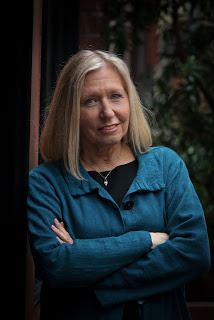 Patricia BracewellPB: It was Emma herself who drew me to early medieval England. I found her story and her character terribly compelling. And yes, there were surprises along the way. One of them was my discovery of how much we actually know about Æthelred’s reign through wills, charters, laws and sermons, not to mention the Anglo-Saxon Chronicleitself. Another surprise was the exact opposite – how very little we know! There are so many details missing or known only by conjecture. What did royal residences, for example, look like in the England of 1002? We can only guess, and not all archaeologists and architectural historians agree. As for the people, we know very little about the activities of Æthelred’s children by his first wife. We don’t know how they related to Emma or if they even spent much time in her presence. That was maddening; at the same time it was freeing. I was able to make it all up.
Patricia BracewellPB: It was Emma herself who drew me to early medieval England. I found her story and her character terribly compelling. And yes, there were surprises along the way. One of them was my discovery of how much we actually know about Æthelred’s reign through wills, charters, laws and sermons, not to mention the Anglo-Saxon Chronicleitself. Another surprise was the exact opposite – how very little we know! There are so many details missing or known only by conjecture. What did royal residences, for example, look like in the England of 1002? We can only guess, and not all archaeologists and architectural historians agree. As for the people, we know very little about the activities of Æthelred’s children by his first wife. We don’t know how they related to Emma or if they even spent much time in her presence. That was maddening; at the same time it was freeing. I was able to make it all up.
JK: The cover of your book shows a woman, presumably Emma, facing an arched, stone gateway. Did you have any input in the design?
PB: I’m very lucky in my editor and publisher, because they did ask for my input and listened to what I had to say. The very first cover design was actually much brighter and far less forbidding. It showed the same woman looking at a distant castle complete with crenellations and a moat. Alarmed, I contacted my editor right away and told her that the fourteenth century castle they had chosen was misleading for a novel set in 1002. There were no castles in England before 1066! The design team went right to work and did some research. They learned that there would have been arched stone entryways in late Anglo-Saxon England, and they chose to show such a gateway on the cover. In addition, the final design had the sense of threat that I was looking for. They did a wonderful job.
JK: That kind of input is rare for an author. Thank goodness they accepted your influence! Has your family always been supportive of your writing?
PB: My family has always been supportive of my writing, and at the same time I have to say that while my two sons were growing up I put my family first. I knew that once my sons reached high school I would be able to devote more of my time to my writing career, and that turned out to be the case.
JK: You've just finished a whirlwind book tour. How did it go?
PB: The tour more than exceeded my expectations. Viking has been wonderful! I arranged a lunch meet at my alma mater with two of my former college English professors (now retired), and when I walked into the office that they share, they each handed me a copy of my book and asked me to sign. That was very special!
JK: How touching! What impression do you hope to make on readers when they've finished Shadow on the Crown?
PB: I hope that readers will come away with some understanding of that murky period before the Norman Conquest, and that they will be intrigued – not just by Emma and her story, but by the rich culture and history of Anglo-Saxon England. I would love for them to be eager to read more about that time, that place, and the people who dwelt within it.
JK: It certainly has that effect on me. Thanks so much, Patricia, for being here.
Shadow on the Crown was released on February 7. Visit Patricia's beautiful site for history and book events.
How to get a free copy of Shadow on the Crown courtesy of Viking:
1. Follow this blog through Google Friend Connect or via email (or indicate in your comment that you already follow).
2. Leave a comment on this post.
3. For an extra point each, tell everyone about the giveaway on Twitter or Facebook.
Open to US residents only (sorry!). One winner will be chosen at random on March 3 at 6 pm CST and announced and contacted by March 4. Good luck!
I was reading The Year 1000 to see if it could tell me something I didn't know about the turn of the eleventh century, in order to use it for The Seven Noble Knights of Lara. (Lots of the atmosphere, none of the history can transfer.) A passing mention of the mysterious, fascinating Queen Emma made me think, "Someone should write a novel about her!" The following week, Shadow on the Crown by Patricia Bracewell came out. It is that novel.

JK: The Year 1000 is a useful book for beginning historical research into the period. Did you encounter any other books that would be accessible to unspecialized readers?
Patricia Bracewell: There are indeed some helpful books out there, some of which you may already have read. The Last Apocalypse by James Reston, Jr. provides a broad look at what was happening in Europe at the end of the first millennium. It’s filled with fascinating gossip about the rulers of the period, although I suspect he plays a little bit fast and loose with facts sometimes! Michael Wood looks at Pre-Conquest England in his book In Search of the Dark Ages . In Bloodfeud: Murder and Revenge in Anglo-Saxon England , Richard Fletcher takes a good look at the politics (and animosities) of the years between 1000 and 1066. For anyone with a specific interest in Emma of Normandy there are two excellent resources: Queen Emma and the Vikings by Harriet O’Brien and Emma: The Twice-Crowned Queen by Isabella Strachan.
JK: Did you read the Anglo-Saxon Chronicle in the original Old English? If so, did it help you set the tone and language for your book?
PB: I have to confess that my knowledge of Old English is limited to a handful of words. I’ve not even seen a copy of the Chronicles in manuscript form - yet. There are versions held at Corpus Christi College, Cambridge, at the British Library in London and at the Bodleian in Oxford, but none easily accessible. I have, though, a wonderful translation by Anne Savage, as well as an older translation by the Rev. James Ingram which is in the public domain, and I’ve used excerpts from that version in the novel. In writing my book I tried very hard to use language that was rooted in Anglo-Saxon, and I sprinkled a number of Old English words into the text to bring the reader into that distant past without drowning him or her in a strange or unwieldy vocabulary. I hope that I’ve succeeded. One reviewer described the England of Shadow on the Crown as a Beowulf-yplace, which I quite liked!
JK: What first drew you to this period and location in history? Was there anything particularly surprising that you found out during writing?
 Patricia BracewellPB: It was Emma herself who drew me to early medieval England. I found her story and her character terribly compelling. And yes, there were surprises along the way. One of them was my discovery of how much we actually know about Æthelred’s reign through wills, charters, laws and sermons, not to mention the Anglo-Saxon Chronicleitself. Another surprise was the exact opposite – how very little we know! There are so many details missing or known only by conjecture. What did royal residences, for example, look like in the England of 1002? We can only guess, and not all archaeologists and architectural historians agree. As for the people, we know very little about the activities of Æthelred’s children by his first wife. We don’t know how they related to Emma or if they even spent much time in her presence. That was maddening; at the same time it was freeing. I was able to make it all up.
Patricia BracewellPB: It was Emma herself who drew me to early medieval England. I found her story and her character terribly compelling. And yes, there were surprises along the way. One of them was my discovery of how much we actually know about Æthelred’s reign through wills, charters, laws and sermons, not to mention the Anglo-Saxon Chronicleitself. Another surprise was the exact opposite – how very little we know! There are so many details missing or known only by conjecture. What did royal residences, for example, look like in the England of 1002? We can only guess, and not all archaeologists and architectural historians agree. As for the people, we know very little about the activities of Æthelred’s children by his first wife. We don’t know how they related to Emma or if they even spent much time in her presence. That was maddening; at the same time it was freeing. I was able to make it all up.JK: The cover of your book shows a woman, presumably Emma, facing an arched, stone gateway. Did you have any input in the design?
PB: I’m very lucky in my editor and publisher, because they did ask for my input and listened to what I had to say. The very first cover design was actually much brighter and far less forbidding. It showed the same woman looking at a distant castle complete with crenellations and a moat. Alarmed, I contacted my editor right away and told her that the fourteenth century castle they had chosen was misleading for a novel set in 1002. There were no castles in England before 1066! The design team went right to work and did some research. They learned that there would have been arched stone entryways in late Anglo-Saxon England, and they chose to show such a gateway on the cover. In addition, the final design had the sense of threat that I was looking for. They did a wonderful job.
JK: That kind of input is rare for an author. Thank goodness they accepted your influence! Has your family always been supportive of your writing?
PB: My family has always been supportive of my writing, and at the same time I have to say that while my two sons were growing up I put my family first. I knew that once my sons reached high school I would be able to devote more of my time to my writing career, and that turned out to be the case.
JK: You've just finished a whirlwind book tour. How did it go?
PB: The tour more than exceeded my expectations. Viking has been wonderful! I arranged a lunch meet at my alma mater with two of my former college English professors (now retired), and when I walked into the office that they share, they each handed me a copy of my book and asked me to sign. That was very special!
JK: How touching! What impression do you hope to make on readers when they've finished Shadow on the Crown?
PB: I hope that readers will come away with some understanding of that murky period before the Norman Conquest, and that they will be intrigued – not just by Emma and her story, but by the rich culture and history of Anglo-Saxon England. I would love for them to be eager to read more about that time, that place, and the people who dwelt within it.
JK: It certainly has that effect on me. Thanks so much, Patricia, for being here.
Shadow on the Crown was released on February 7. Visit Patricia's beautiful site for history and book events.
How to get a free copy of Shadow on the Crown courtesy of Viking:
1. Follow this blog through Google Friend Connect or via email (or indicate in your comment that you already follow).
2. Leave a comment on this post.
3. For an extra point each, tell everyone about the giveaway on Twitter or Facebook.
Open to US residents only (sorry!). One winner will be chosen at random on March 3 at 6 pm CST and announced and contacted by March 4. Good luck!
Published on February 27, 2013 00:21
February 25, 2013
Guest Post Today: Begin at the Beginning (Help!)
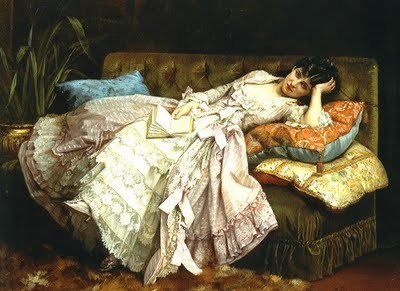 What to do? What to do?
What to do? What to do?Today I'm at the kind and talented Dixon Rice's blog, revealing how I decide to begin my stories. And begging for your help!
I'm stuck over how exactly to begin The Seven Noble Knights of Lara. What would draw you in as a reader? Please comment below or at Dixon's post. Thanks!
And come back here on Wednesday for a really great (if I do say so myself) interview with Patricia Bracewell, author of the historical hit Shadow on the Crown and enter the giveaway!
Published on February 25, 2013 00:27
February 20, 2013
Libraries and Their Relationship to... Books...
As a true bibliophile, I love libraries, public or private, big or small. I proudly served in the catalog department at the Boston University Law School Library for as long as I could before destiny took me other places.
As books move into digital formats, libraries have to figure out ways to stay abreast of it all. A. K. Marshall, who is also a writer, has recently called attention to the way some confused companies are shortchanging both libraries and themselves. The publishing industry, to repeat what's become a platitude, is undergoing a complete upheaval. I hope publishers can come up with useful, fruitful ways to collaborate with bookstores and libraries in the near future.
In a similar librarians-kick-ass mode, see some of the most interesting rules and special requests at libraries nationwide here.
I've also seen on social media that it's happened: a librarian has been asked for "the book by that mental writer" -- a request for Bring Up the Bodies by Hilary Mantel.
As books move into digital formats, libraries have to figure out ways to stay abreast of it all. A. K. Marshall, who is also a writer, has recently called attention to the way some confused companies are shortchanging both libraries and themselves. The publishing industry, to repeat what's become a platitude, is undergoing a complete upheaval. I hope publishers can come up with useful, fruitful ways to collaborate with bookstores and libraries in the near future.
In a similar librarians-kick-ass mode, see some of the most interesting rules and special requests at libraries nationwide here.
I've also seen on social media that it's happened: a librarian has been asked for "the book by that mental writer" -- a request for Bring Up the Bodies by Hilary Mantel.
Published on February 20, 2013 00:25
February 18, 2013
Interview and Excerpt, No Turning Back
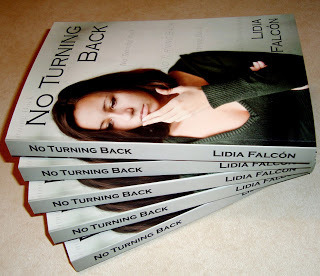
Today I'm appearing in an interview about No Turning Back at Marta Merajver's Corner. And don't miss the accompanying excerpt on her blog -- all of Chapter 6! That chapter was one of the most harrowing to translate. It really shows what was at stake for political prisoners in Spain in the '70's. It's just one of the factors that make this book unforgettable for me. Enjoy!
Published on February 18, 2013 00:37
February 17, 2013
Second Historical Fiction Blog Hop!
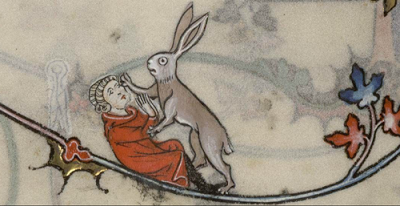 Another medieval rabbit for a historical hop. This one is too weird to pass up!
Another medieval rabbit for a historical hop. This one is too weird to pass up!The basic rules for participation in this new hop are in a previous post.
The six exclusive, excellent excerpts for our first Backward in Time Hop are at the following links:
Jessica Knauss - The Seven Noble Knights of Lara
In a Milk and Honeyed Land
Misfits and Heroes
Ascroft, eh?
Jenna Jaxon
Tree Soldier
A million thanks to all the participants for joining and a billion thanks to all the readers who come here looking to discover new historical fiction authors. Feel free to comment on each post! Share the love!
Published on February 17, 2013 00:09
February 13, 2013
Bullfighting in My Time
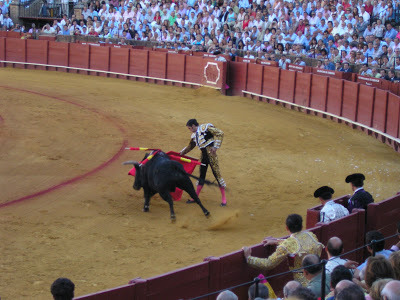 I snapped these pics when I splurged on sitting on the shady side at the
I snapped these pics when I splurged on sitting on the shady side at the Maestranza Bullring in Sevilla in September 2005.When I first started to love Spain, I loved bullfighting right along with it. I loved the spectacle, the daring, the honor. The complex structure and the different opportunities each fighter had to show his prowess were fascinating, and the culture of poor young men (and more recently women) being able to make it big through talent, guts, and life-risking seemed like a fairy tale.
In the summer of 1998, I went to the Maestranza bullring in Sevilla every Sunday to sit in the sweltering sun and see the apprentice bullfighters get more kills under the belts, with mixed results. Even at its goriest, the whole ritual was a heady thrill to me, inflaming all my sensibilities that preferred "Spanishness" above all. None of the American students in my group went with me. None of them had the same sense of Spain that I did. I took my mother in September 2005 and leaned forward to get a better look when she covered her eyes.
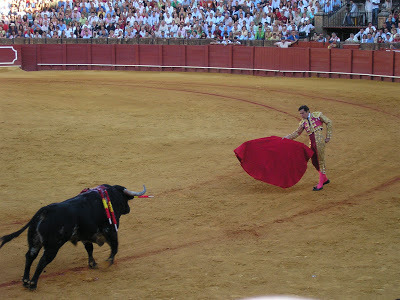
If anyone asked how I could conscience such a practice, I argued the following:
• The bull represents a Roman god who must be defeated. This is a battle of good versus evil that will continue in some form for all time.
• The bulls live fantastic lives, free range, doing what they like, for years. The end of that charmed life is unpleasant, but it's short.
• Sure, the bull always loses, but sometimes the man loses, too, so it's not as unfair as you would think.
• The meat is not wasted, but served as food in the bars around the bullring. You might as well get a spectacle out of the necessary butchering.
• There is no way to love Spain as much as I do and not like a good bullfight. It's the single most Spanish institution, period.
The Canary Islands banned bullfighting in 1991, but that could hardly threaten my sense of cultural unity, because the Canary Islands sit far away, off the coast of Africa. Catalunya's 2010 ban (effective 2012) didn't phase me, either, because Catalunya is an autonomous region with its own language and which has never desired to appear culturally attached to the rest of the peninsula.
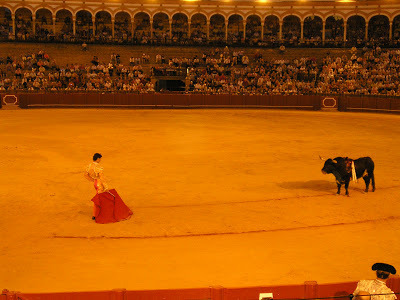
But this year I finally woke up to hypocrisy of enjoying los toros while being outraged to the core that precious, rare, rhinoceroses are all too routinely killed for sport and monetary gain. I can easily argue against my previous self:
• A real, live bull represents only himself.
• There are many ways beef can be butchered without causing terror, rage, and profuse bleeding in the animal. Terror, rage, and bleeding are all things we could do with less of in the world.
• Any game with the threat or certainty of death of either party belongs in the realm of fiction, not the real world.
• It's insane to enjoy watching death, whether the meat is going to be used later or not.
• In the final analysis, one does not need to recreationally kill bulls to prove his or her Spanishness.
There is a whole industry built around bullfighting, and far be it from me to want to put even more Spanish citizens out of work. But inevitably, the practice will fade and I'm now on the side of those who hope it will fade sooner rather than later.
In the future, I will only go to a bullring to attend musical events. (Yes, bullrings can be used for any stadium-type event! No waste of architecture! I also think the bullfighting museums should remain open to keep that part of history fresh in people's minds.) I can't wait to go back and investigate what exactly the essence of Spain involves, now that bullfighting is out of my mental picture!
Published on February 13, 2013 00:18



